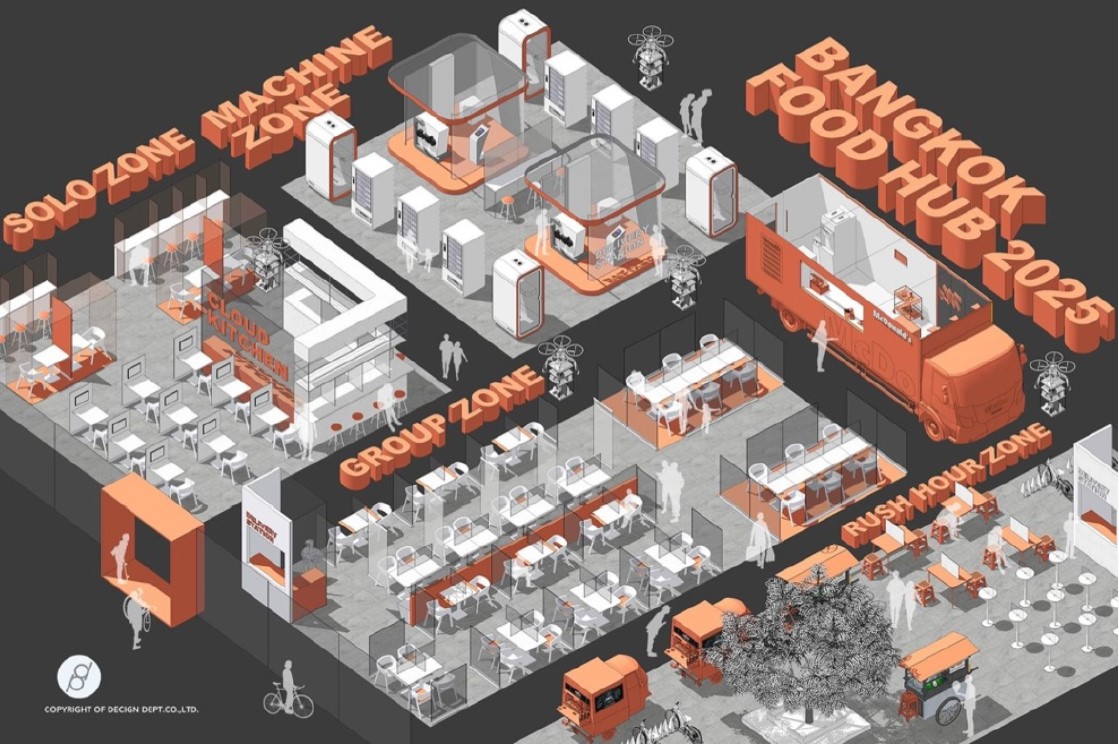
by Dichila Pasanta
Department of Interior Architecture,
Montfort del Rosario School of Architecture and Design, Assumption University
Type of creative work : Design
Food hub for future Covid 19
After COVID 19 pandemic forced changes for all businesses, one of the largest business impacts is all types of restaurants. As owners needed to reduce high-risk activities, operations and services have to change significantly. During this uncertain time, restaurant owners need to think how to convince consumers to comfortably come to the restaurant again. This project objectives derived from our clients, restaurant owners who are seeing their operations quickly shifting gear to delivery food service. At the same time, they have to figure out the best solution, if delivery food service is not enough to completely heal their business, alternative service options need to be quickly developed.
At the beginning of this situation almost all types of restaurants were forced to close without any clear indications as to: When they can reopen? What are the clear regulations? No one knows what restaurants will look like when they reopen during or after this period. However, as owners and consumers were both affected by this pandemic, they have to adjust to the new normal. Furthermore, for pre-vaccine COVID-19 period, social distancing became a new proportion to buy time and slow down the spread by avoiding overcrowding. Unluckily, social distancing can badly affect the number of customers per one restaurant.

Existing restaurant seating compared to new social distancing layout. 30% of total space is kitchen but serve only half of customers.
After interviews and surveys, food hub solution project is a mimetic setting for foreseeable to help our clients run their business in the interim period. When work from home ends, as people need to go back to work at the office, social distancing might not be efficiently concerned. So the questions are: How can restaurant operation reduce capacity and stay in business? How many restaurants can set up outdoor or patio dining? How can people trust that this is protective enough? Many offices have set up new spaces for food delivery for lunch but not all offices are capable of doing so.
The future direction for food hub solution will be set as 2 key steps
1. Fewer seating and limited density in the restaurant will become the new norm. As a result, kitchen is removed and replaced by cloud kitchen. The seating can take over kitchen, which is counted as 30% of the total area. The new normal restaurants are now without a kitchen but they can still deliver the food from a nearby cloud kitchen. One cloud kitchen can serve at least 3 branches. This can work better as renting more space is not an option if the owner wants to efficiently operate the existing one.

Eating zone would be reorganise, according to the new distancing, and can be developed into Co-Eating Space operated by one organisation under the government. The restaurant owner will pay for a rental eating space instead of having to pay extra cost to set up new ones.
The area then become more like a food court without kitchens but with only seating area. Co-Eating Space will be set up in the Food Hub area, where many restaurants can share the eating space.
2. After setting up Co-Eating Space, zoning is the next step. Each zone can be divided according to types of food and types of people. To reduce physical contacts during pandemic, online application platform can used. Seat booked with food will be confirmed after using online ordering apps. The owner can be sure that all seating will be set up at Food Hub. Last thing to do is to deliver all food from cloud kitchen on time.
Co-Eating Space development
Eating behavior, and number of seating will be organized as zonings below
Rush hour zone – Grilled pork with sticky rice is the best for early morning hour, when seating is not necessary for street food.
Solo Zone – If you are single, this area is perfect, but if not, private area is available for someone who comes alone.
Group zone – For couples or family seating, booking for group zone is a good choice for after work dinners.
Machine Zone – As fully-booked food and Co-eating area is possible, food vending machines can be provided. However, during rush hour, this area might also be suitable.
All eating area would be facilitated by Co-Eating Space operation. Eating regulations and indications would be well operated according to the government guidelines. Restaurants only need to set up cloud kitchen and deliver food to this place without any operation concerns. Moreover, consumers can trust that this place poses no risks for pandemic spread. Cost for operations and services can be reduced as there is no need to hire waiters for dish serving hence restaurant rental cost per branch can also turn into other benefits.



Food Hub is the creative design project, which proposes potential new normal direction for current situation and for the future. If COVID-19 continues to stay with us, the ultimate objective of food hub project is to keep restaurants in business with well operations and allowing consumers to comfortably come to use the space. The world after COVID-19 might be forced to reduce the number of people in one place, therefore restaurants will be no longer be only in the department stores but also within mall areas. Eventually, the normal restaurant with its own kitchen may be transformed into to co-eating space as ‘FOOD HUB’.
